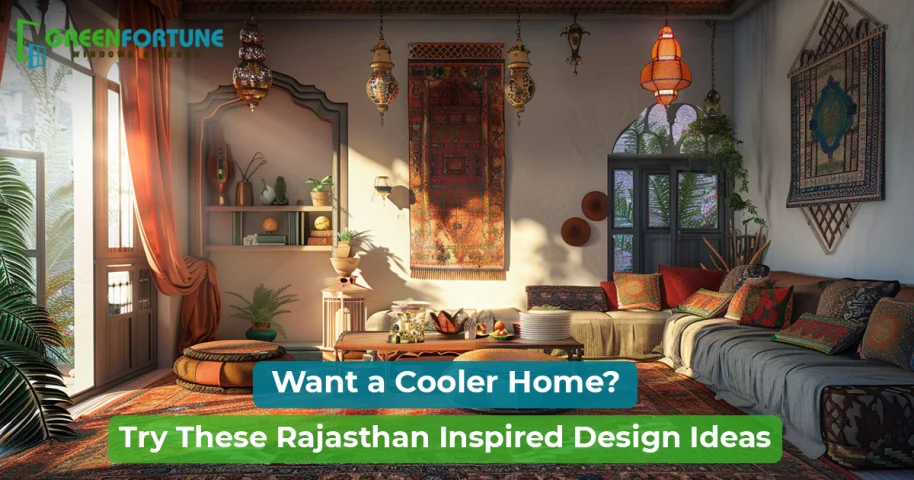
Why Timeless Delhi Architecture Inspires Modern Architecture Today?
July 10, 2025
Why Telangana Architectural Style Is Perfect For Airy & Comfortable Living
July 10, 2025Summers in India are unforgiving, especially in the northern regions where temperatures can go beyond 45°C. Still, among the golden sands stand traditional Rajasthan homes—a testament to desert architecture that remains cool even when the heat seems unbearable. These home designs are inspired by royalty and climate, offering creative and functional home ideas.
The Rajasthani home design is a mix of regal grandness and sustainability. These home designs are naturally designed to beat the heat, and the best part is that you don’t need to live in a Rajasthani Haveli to enjoy the brilliance of the design.
In this blog, let’s see how you can transform your home into a cooler oasis this summer, just like traditional Rajasthani homes!
What Is A Rajasthani Home Design?
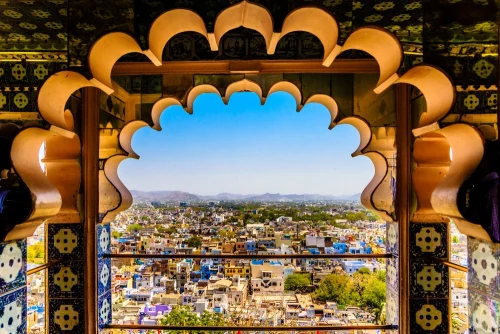
Source: Freepik
Traditional Rajasthan homes are a balance between art, culture, and climate-adaptive design. A typical Rajasthani Haveli design is not just functional but also visually pleasing due to arched doorways and a vibrant array of colours.
The typical features of these home designs include:
- Use of stone, lime plaster, or mud for thermal insulation
- High ceilings to keep the home cooler
- Overhanging windows or latticed screens (Jali) for natural light and ventilation
- Central courtyards and open verandas for better airflow
- Flat or domed roofs that reflect heat
Now, let’s look at some cool home ideas that are inspired by traditional Rajasthani homes and how you can incorporate the designs into a modern home.
Also Read: Passive Cooling Design Ideas for Indian Homes: Stay Cool Naturally
Cool Home Ideas Inspired By Traditional Rajasthani Homes
1. Thick Insulating Walls
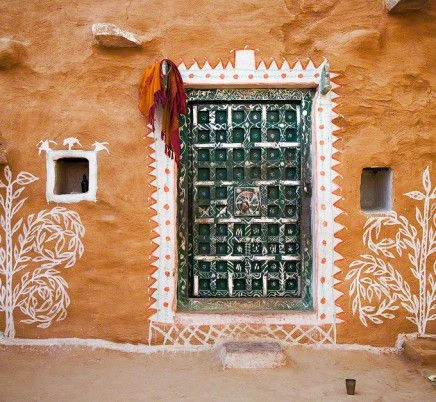
Source: Pinterest
Traditional Rajasthan homes have thick walls made of lime plaster, stone, or mud to insulate the home from summer heat. To upgrade your home and keep it cool, you can use lime wash or natural clay to keep indoor surfaces cool. Moreover, you can choose light-coloured paints that reflect heat instead of absorbing it.
2. Jaali Design for Natural Ventilation
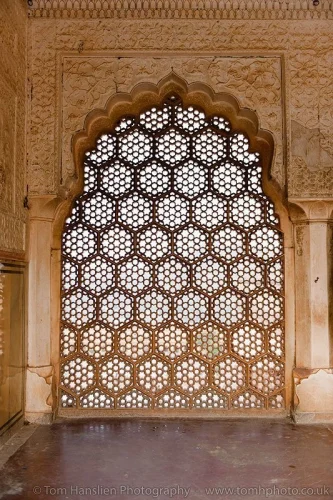
Source: Pinterest
One feature of Rajasthani haveli design is the jaali work or latticed screens made from wood or stone. These jaali designs can regulate airflow and keep your interiors cool and private. In your home, you can add jaali screens to your balconies, windows, or even garden for better and cooler airflow.
3. Central Courtyard or Veranda Design
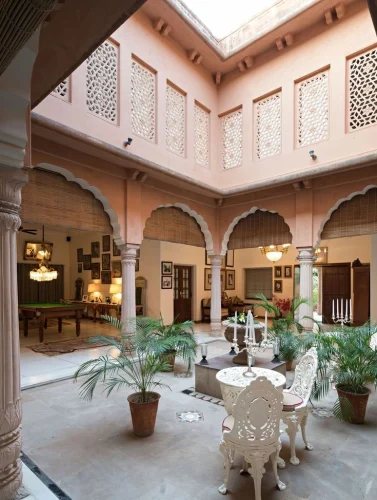
Source: Pinterest
At the heart of traditional Rajasthan homes is a courtyard also called an aangan. This open central courtyard can be an ideal choice for natural ventilation. Moreover, verandas are also a main feature of these desert homes. You can convert your backyard or patio into a shaded veranda or grow plants like neem or lemongrass for cool air and purification.
4.Terracotta or Stone Floors
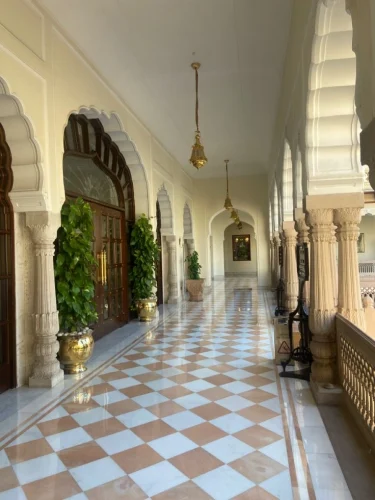
Source: Pinterest
In traditional Rajasthani houses, you can find terracotta tiles, sandstone, or Kota stone work, as they naturally keep the floors and walls cool. So, in your next home renovation, you can replace synthetic flooring options with terracotta or stone. The benefits of these materials are that they naturally resist heat, are durable and low maintenance.
5. Flats Roofs With Insulation
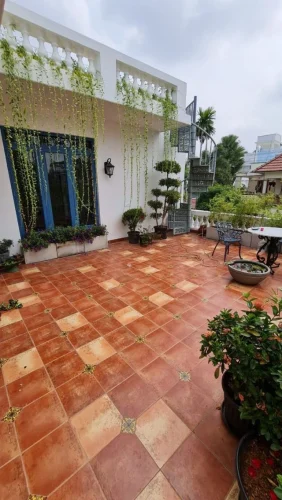
Source: Pinterest
Flat roofs, in particular, are more popular in Rajasthan homes as they help reflect heat and keep the interiors cooler. Some homes even use lime plaster on their rooftops for better thermal insulation. To keep your home cool in summer heat, you can also use lime plaster or reflective paints for insulation. Other than that, you can install a terrace garden to naturally reduce heat.
6. Water Features for Cooling
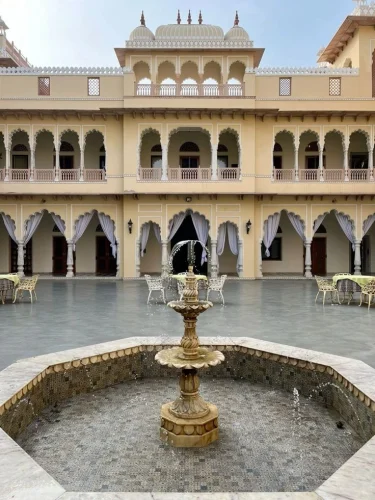
Source: Pinterest
One thing you’ll often notice in Rajasthani havelis is stepwells and fountains. These water features don’t just add beauty to a home, but also serve as a cooling element. Installing these features in your home can reduce the temperature, so to keep your home cool, you can add a small fountain or bird bath on your balcony or veranda or use matkas with water to absorb heat.
7. Arch Doorways & Wooden Windows
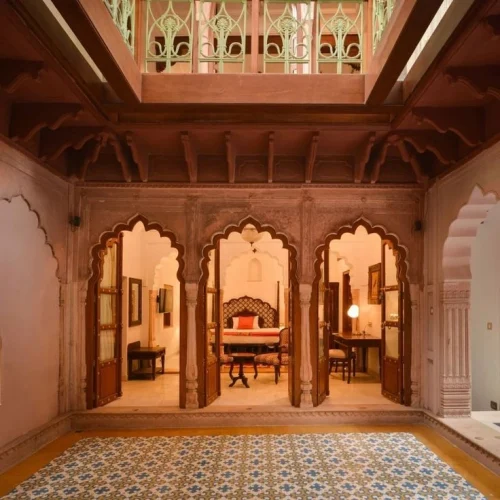
Source: Pinterest
In old homes, you might notice more use of wooden shutters and thick wooden doors. This is because wood is a bad conductor of heat. In a typical Rajasthani haveli design, arched doorways and wooden windows help in better air circulation. You can also choose to install wooden shutters instead of metal or use arches in home interiors. Just like a royal Rajasthan haveli!
8. Decorate with Breathable Fabrics
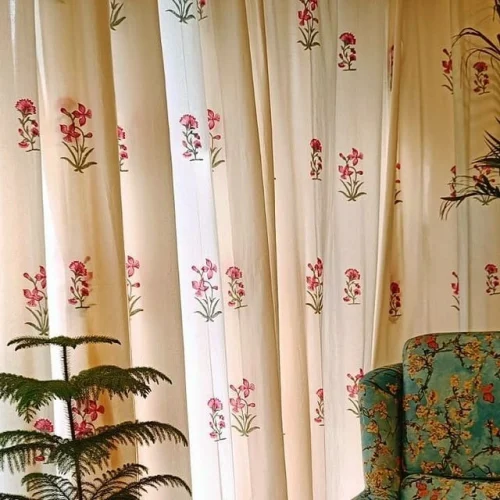
Source: Pinterest
Traditional Rajasthan homes use breathable fabrics such as cotton, khadi, and linen to decorate their interiors. These fabrics keep the temperature of the interiors cool, making them ideal for regions with a hot climate. You can switch your curtain, pillow, or bedsheet fabrics to cotton, decorate with bamboo blinds, or install cane furniture. For an aesthetic look, you can choose Rajasthani textile designs like lehriya, sanganeri, bagru, or block prints for upholstery.
9. Install Overhangs and Awnings
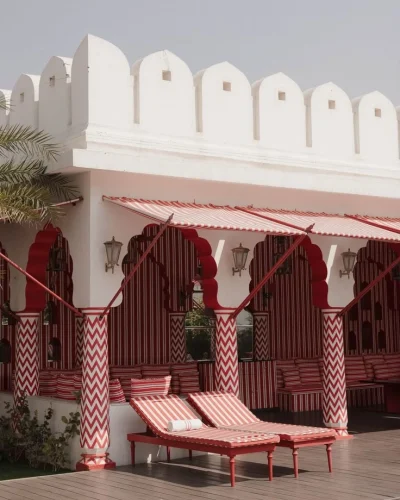
Source: Pinterest
In Rajasthan havelis, overhangs and awnings are a common sight. These features can reduce sun exposure and give more shade, keeping homes cool. If you want to adopt this feature into your home, then you can install canopies or fabric awnings on your rooftop or windows, grow vines over a mesh fence to block direct sunshine, or use bamboo blinds to protect your home from the summer heat.
Also Read: Best Windows for Indian Climate: Designs for Every Region
What Makes Desert Architecture Unique?
Climate-Conscious Aesthetics
Instead of giving in to the Rajasthan heat, the desert architecture welcomes it. The homes designed with Rajasthani features can include earthy tones, jharokhas, and thick walls that can be considered more climate-conscious than anything else. This natural cooling approach is functional and sustainable.
Balanced Space
The design of typical Rajasthan homes with courtyards and verandas is a testament to balanced space sharing. This kind of home design shows a deep appreciation and sense of togetherness without compromising privacy.
Styling with Local Materials
Furthermore, Rajasthan homes use local resources such as stone, lime, and wood to build and decorate their exterior and interior. This styling with local materials shows that you don’t need imported goods to make your living space beautiful or functional.
Final Words:
Summer heat in the northern regions of India can be both relentless and energy-draining. Inspired by traditional Rajasthan homes, these designs are naturally cooling, sustainable, energy-efficient, and simple. These cool home ideas are rooted in a regal and artistic heritage and can transform your living space into a comfortable and graceful home. A home that stays climate-conscious throughout every season.
Why Choose Green Fortune uPVC Windows & Doors For Your Home?
Green Fortune is one of the leading manufacturers of high-quality uPVC windows and doors. Our products are sustainable, durable, energy-efficient, and aesthetic, which can transform your home for functionality and style. Green Fortune also provides customisable home solutions to meet your specific needs and preferences. To explore more about Green Fortune products and home improvement solutions, visit our website here.
Frequently Asked Questions (FAQs):
Q: How to keep a house cool in summer naturally in India?
To keep a house cool in summer, you can focus on blocking direct sunlight and improving airflow. This can be done by cross-ventilation, using bamboo blinds, or choosing breathable fabrics like cotton for pillows, drapes, and bedding.
Q: Why do houses in Rajasthan have thick walls?
Houses in Rajasthan have thick walls to maintain temperature and provide insulation against the brutal heat of the desert. The thick walls in Rajasthan homes are often made of stone or mud to absorb heat during the day and release it at night, keeping the house cool in summers and warm in winters.
Q: What is the best roof for a hot climate?
The best roof design for a hot climate can be clay or concrete tiles. These rooftop materials provide good insulation, reflect sunlight, and keep the house relatively cooler. Moreover, coating the roof with cooling materials can further improve its reflectivity.








